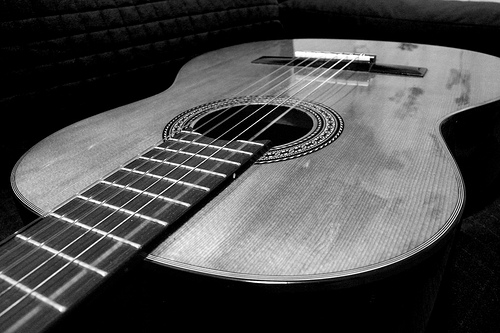Although the instruments that would eventually evolve to become the guitars we know today can trace their route back thousands of years, usually to central Asia, what we know as the classical guitar today wouldn’t be born until the European Renaissance period, originating out of Spain sometime in the late 16th century.

Renaissance Period Guitars
Renaissance guitars, although looking similar to what we know as a guitar today, actually had eight strings, rather than six. These eight strings were made up of four pairs, which were known as courses.
The guitars used throughout the Renaissance period bore similarities to a Spanish instrument called the vihuela, which again closely resembled what would become the classical guitar. One major difference was that the vihuela has six courses – twelve strings – as opposed to four.
Evolving Classical Guitars
Spanish music theorist and mathematician Juan Bermudo presented a treatise on stringed instruments in the mid-16th century, which would go onto influence the appearance and sound of both the vihuela and standard Renaissance guitar.
Eventually, both models would become five course instruments, each course being A, D, G, B, and E, which to this day remain five of the strings on a standard guitar. This would become the most commonly seen instrument throughout the 17th century, and by the 18th century various musicians were phasing out courses and instead using single strings to get the sound they wanted. This would eventually lead to the birth of the six-string guitar as we know it today, which would be the standard design come the middle of the 18th century.
These new guitars were much smaller than the instruments we are used to today, originally staying true to the smaller styles seen with flamenco guitars. One final innovator and idea would turn them into the instruments we now call guitars.
Antonio de Torres
This Spaniard is widely credited as being the inventor of the modern guitar, his designs being the inspiration behind the hundreds of acoustic guitar variations that we see used by musicians and in music stores today.
The modern classical guitar is also known as the Spanish guitar, owing to its origins both in current form as well as going back to the Middle Ages and Renaissance when they’d first become popular.
Moving Forward
Later in the 18th century, various manufacturers would begin producing acoustic guitars, and by the end of the century the Gibson Guitar Corporation, albeit with a different name and mission at that time, would be formed.
Image Source: Carlosinho
Are you a guitarist? Check out our full range of online guitar lessonsAre you a saxophonist? Check out our full range of online saxophone lessons
Subscribe to Pro Music Tutor from as little as £7.99 per month
Related Posts
-
Is Music Theory Important to Modern Musicians?
The importance of music theory is a hot debate topic in the world of professional music. Some believe knowledge of music theory is what makes you a true musician, whereas some feel their lack of music theory knowledge is like a badge of honour. With the eternal debate over the importance of music theory raging […]
View All >> -
5 Ways Spanish Music Influenced the World
Contemporary popular music has transcended all national boundaries, with different types of music being performed and listened to in all corners of the world. Each culture also adds their own little tweaks and twists to the music, constantly creating new sounds and influences. Spanish music has deeply influenced the popular music we listen to today. […]
View All >>
Latest Blog Entries
-
The Benefits of Online Music Education
Learning music has never been easier, since the internet and modern technological advancements have opened the doors to countless possibilities, expanding the subjects people can choose from and how the lessons are taught. Now, people can study a whole host of music-related topics; from learning to play guitar or DJing, to understanding the inner workings […]
View All >> -
Essential Jazz Guitar Scales that are Easy to Learn
Improvising in jazz requires the ability to play in different keys over different chords. Results certainly do not come overnight, but with diligent practice, you would be surprised by what you can achieve. Many people ask me about what scales I use as if they were some big secret. While knowing your scales is very […]
View All >>
Blog Categories
- Categories
- Guitar Tips (93)
- History (36)
- How-To (38)
- Interviews (3)
- Music Industry (121)
- Prolinks Guitar (2)
- Prolinks Lessons (3)
- Prolinks Tutor's Profile (1)
- Saxophone Tips (40)
- Uncategorized (6)
Tags
Archive
- November 2018 (1)
- February 2018 (1)
- December 2017 (1)
- November 2017 (1)
- October 2017 (1)
- July 2017 (4)
- May 2017 (2)
- April 2017 (1)
- August 2016 (2)
- July 2016 (1)
- June 2016 (2)
- May 2016 (3)

